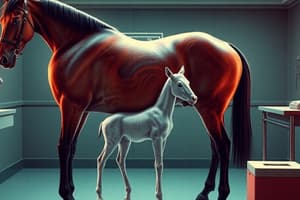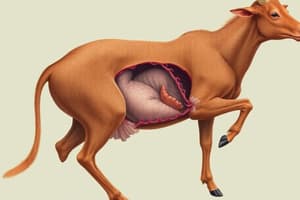Podcast
Questions and Answers
What marks the beginning of the 2nd stage (Expulsive stage) of labor?
What marks the beginning of the 2nd stage (Expulsive stage) of labor?
- Start of contractions
- Full dilation of the cervix
- Delivery of the placenta
- Cervical dilatation or appearance of fetal sacs (correct)
What is the main event that occurs during the 2nd stage (Expulsive stage)?
What is the main event that occurs during the 2nd stage (Expulsive stage)?
- Preparation of the uterus
- Cervical effacement
- Expulsion of the fetus (correct)
- Engagement of the fetal head
During which stage does the cervical dilatation and fetal sac appearance occur?
During which stage does the cervical dilatation and fetal sac appearance occur?
- Expulsive stage (correct)
- First stage of labor
- Transition stage
- Postpartum stage
Which of the following is NOT a characteristic of the 2nd stage (Expulsive stage)?
Which of the following is NOT a characteristic of the 2nd stage (Expulsive stage)?
What is the duration of the 2nd stage (Expulsive stage) mainly characterized by?
What is the duration of the 2nd stage (Expulsive stage) mainly characterized by?
What initiates the fetus's birth position during the initial myometrial contraction?
What initiates the fetus's birth position during the initial myometrial contraction?
Which statement accurately describes the regular intermittent contractions during expulsion?
Which statement accurately describes the regular intermittent contractions during expulsion?
What is the consequence of prolonged contraction without rest on the fetus?
What is the consequence of prolonged contraction without rest on the fetus?
What occurs before the rupture of the fetal membrane?
What occurs before the rupture of the fetal membrane?
How can the fetal membrane be compromised during labor?
How can the fetal membrane be compromised during labor?
What is the maximum duration a cow can take to deliver afterbirth in summer?
What is the maximum duration a cow can take to deliver afterbirth in summer?
Which animal is expected to have the shortest afterbirth duration?
Which animal is expected to have the shortest afterbirth duration?
What duration is associated with sheep and goats after the last lambing?
What duration is associated with sheep and goats after the last lambing?
What is the indication of retained afterbirth duration for cows?
What is the indication of retained afterbirth duration for cows?
Which of the following animals does not have an afterbirth stage?
Which of the following animals does not have an afterbirth stage?
What is the typical interval between the birth of piglets?
What is the typical interval between the birth of piglets?
When may portions of the placenta be passed during the birthing process?
When may portions of the placenta be passed during the birthing process?
What color might the chorionic surface of the last pieces of placenta from each horn be?
What color might the chorionic surface of the last pieces of placenta from each horn be?
In regard to piglet births, which statement is true?
In regard to piglet births, which statement is true?
Which of the following statements about placenta during birthing is false?
Which of the following statements about placenta during birthing is false?
What physiological change occurs in a queen's body temperature prior to giving birth?
What physiological change occurs in a queen's body temperature prior to giving birth?
What causes the dark brown discharge observed during a queen's delivery?
What causes the dark brown discharge observed during a queen's delivery?
How long before birth does the body temperature of a queen change?
How long before birth does the body temperature of a queen change?
Which of the following best describes the nature of the discharge during the delivery of a queen?
Which of the following best describes the nature of the discharge during the delivery of a queen?
What significance does the change in body temperature have in a queen before parturition?
What significance does the change in body temperature have in a queen before parturition?
What distance from the puppy or kitten does the bitch sever the umbilical cord?
What distance from the puppy or kitten does the bitch sever the umbilical cord?
When may the placenta be delivered during parturition?
When may the placenta be delivered during parturition?
Which of the following statements is true regarding the delivery of the placenta?
Which of the following statements is true regarding the delivery of the placenta?
What role does the bitch play in severing the umbilical cord?
What role does the bitch play in severing the umbilical cord?
Which statement best describes the timing of placenta delivery?
Which statement best describes the timing of placenta delivery?
Flashcards
Expulsive stage
Expulsive stage
The stage of labor from cervical dilation to fetal expulsion.
Cervical dilatation
Cervical dilatation
Widening of the cervix during labor.
Fetal sac
Fetal sac
Membrane enveloping the fetus.
Labor stages
Labor stages
Signup and view all the flashcards
Fetal expulsion
Fetal expulsion
Signup and view all the flashcards
Mare's afterbirth
Mare's afterbirth
Signup and view all the flashcards
Cow's afterbirth
Cow's afterbirth
Signup and view all the flashcards
Sheep & goat afterbirth
Sheep & goat afterbirth
Signup and view all the flashcards
Sow's afterbirth
Sow's afterbirth
Signup and view all the flashcards
Bitch and Queen afterbirth
Bitch and Queen afterbirth
Signup and view all the flashcards
Fetal membrane rupture
Fetal membrane rupture
Signup and view all the flashcards
Contraction (stages)
Contraction (stages)
Signup and view all the flashcards
Fetal position and contraction
Fetal position and contraction
Signup and view all the flashcards
Umbilical cord stoppage
Umbilical cord stoppage
Signup and view all the flashcards
Chorioallantoic membrane
Chorioallantoic membrane
Signup and view all the flashcards
Piglet birth interval
Piglet birth interval
Signup and view all the flashcards
Placenta expulsion
Placenta expulsion
Signup and view all the flashcards
Placenta color variation
Placenta color variation
Signup and view all the flashcards
What is 'furrowing'?
What is 'furrowing'?
Signup and view all the flashcards
How long does it take for piglets to be born?
How long does it take for piglets to be born?
Signup and view all the flashcards
Bitch's Teeth
Bitch's Teeth
Signup and view all the flashcards
Placenta Delivery
Placenta Delivery
Signup and view all the flashcards
Parturition
Parturition
Signup and view all the flashcards
Umbilical Cord Separation
Umbilical Cord Separation
Signup and view all the flashcards
Placenta Timing
Placenta Timing
Signup and view all the flashcards
Queen's body temperature before birth
Queen's body temperature before birth
Signup and view all the flashcards
Dark discharge during Queen delivery
Dark discharge during Queen delivery
Signup and view all the flashcards
What is the 'furrowing' process?
What is the 'furrowing' process?
Signup and view all the flashcards
Placenta expulsion in a sow
Placenta expulsion in a sow
Signup and view all the flashcards
Study Notes
Stages of Parturition
- Parturition stages were traditionally 4, but the preparatory stage, being too long, was removed, leaving only 3 active stages.
- There's no clear division between stages, only indicators that a stage is ending, without defined timing.
- Stage 1 (Opening/Dilatation): Begins with labor pain and ends with cervical dilation or fetal sac emergence.
- Stage 2 (Expulsive): Starts with cervical dilation/fetal sac emergence and ends with fetal expulsion.
- Stage 3 (After Birth): Starts with fetal expulsion and ends with expulsion of fetal membranes and placenta.
External Changes
- Animals show restlessness, stop eating, frequent urination, soft defecation, straining, and frequent lying/standing.
- Pawing, raising the tail, and muscle tremors are common signs.
- Animals often recline to move the fetus from the abdominal cavity to the pelvis.
Internal Changes
- Cervix: Relaxation and dilation, becoming indistinguishable from the vagina.
- Myometrial Contractions: Initial contractions involve only the inner circular muscles, helping the fetus assume birth position and move towards the cervix. Regular, intermittent contractions (30 seconds of contraction, followed by 120 seconds of rest).
- Additional Contractions: Later contractions include outer longitudinal muscles, aided by abdominal contractions and elevated chest pressure, creating more pressure to push the fetus out (higher E2, PGF2a and Oxytocin).
Fetal Membrane Rupture
- The first membrane to rupture is the chorioallantoic membrane (bluish, vascular, semi-transparent), followed by the amnion (grayish-white, avascular, opaque).
- Rupture is mainly caused by twisting or rubbing against hard objects, dampness around the perineum, or manual rupture.
- Rupture happens after cervical dilation
Duration
- Cow's: 4-6 hours for pluriparous cows, 6-12 hours for primiparous cows, can go longer if retained placenta (more in summer).
- Mare: Less than 0.5 hours (shorter than cows); placenta separation occurs during expulsion phase.
- Sheep/Goat: 0.5-2 hours (longer in first lambing).
- Sow: Within 2 hours after last piglet.
- Bitch/Queen: No distinct after birth stage.
- 80% of allantoic rupture first, 20% of amniotic rupture first.
Animal Positions During Partuition
- Animals often prefer a recumbent position to aid fetal expulsion.
- Lateral recumbency is common in cows, to facilitate fetal movement.
- Sternal recumbency is preferable if there's dystocia to maximize space for assistence.
Other Important Points
- Premature rupture of the umbilical cord can be problematic in neonatal animals.
- Animals may eat the placenta, but large amounts may cause vomiting.
- In some animals, the fetus may be born enclosed in the amnion.
- Significant blood reserves remain in the placenta, so it needs to be delivered efficiently for a healthy calf.
- Manual intervention for placenta expulsion may be necessary in some cases, while a wait-and-see approach is good for others.
- In some species, there are particular factors, such as the presence of a more fibrous cervix, that contribute to the slower progress of parturition.
- Some animals may experience a slight temperature drop before or after giving birth.
Studying That Suits You
Use AI to generate personalized quizzes and flashcards to suit your learning preferences.




